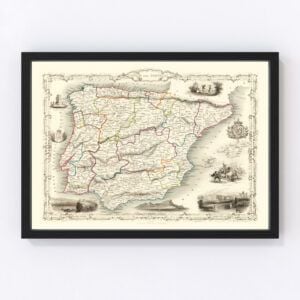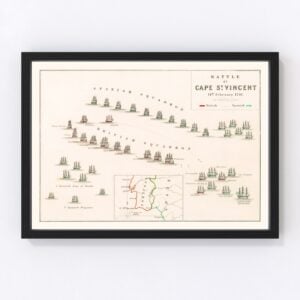Old Maps of Portugal
Browse through our collection of Old Maps of Portugal.
Portugal is a country located on the Iberian Peninsula within Southwestern Europe. The country shares a border with Spain, which is the only country to share a land border with Portugal. The capital, and largest, city is Lisbon. Spreading a total area of 92,212 square kilometers, or 35,603 square miles, Portugal is the 109th largest country in the world by area. The total population of the country is 10,352,042 inhabitants, which makes Portugal the 82nd most populated country. The country’s government is a semi-presidential representative democratic republic, and the current prime minister is António Costa.
The country of Portugal is split by its main river, the Tagus. The northern region of the country is primarily mountainous, while the southern region is dominated by rolling plains. The highest point within the country is Mount Pico, an ancient volcano that reaches 2,351 meters, or 7,713 feet in the air. The archipelagos of Portugal were formed from volcanic events, and are all located on some sort of plate movement hotspot. The most recent occurrence of a volcanic eruption took place in 1957. There are very few earthquakes, however they are all minor and hold very low intensities.Because of its location in the Mediterranean Basin, Portugal is a biodiversity hotspot. There are six different ecoregions within the country, 62 special conservation areas, and 88 different protected landscape natural habitats. The larger mammal species of Portugal include the fallow deer, red deer, roe deer, iberian ibex, wild boar, red fox, and the iberian wolf. Some smaller mammals include the red squirrel, european badger, eurasian otter, egyptian mongoose, and the european rabbit. Because of its location, the country is a hotspot for migratory bird species, with different regions home to different birds. As of 2020, Portugal has the second highest number of endangered species, with 488.
Portugal is a high-income and developed country, which can be shown in their economy. The primary exports from the country include cars, vehicle parts, delivery trucks, refined petroleum, leather footwear, uncoated paper, wine, knit t-shirts, and seats. Since the 1990s, the economy has been focused on developing and modernizing primarily in the high-tech sector. Traditional industries, such as textiles, clothing, footwear and cork, have been making a comeback. In fact, Portugal is the world’s largest cork producer. Agriculture in Portugal is based on small family owned farms, and the most popular crops produced are tomatoes, citrus, green vegetables, rice, carob, chestnut, and pulp.
Portugal’s population has remained homogenous, and the main contributors to this are the single religion and language the country focuses on – Roman Catholicism and Portuguese. In 2015, the Total Fertility Rate was estimated to be 1.52 children born per woman, which is extremely below the high TFR in 1911, which was 5.02 children born per woman. Since the 1980s, Portugal has had to deal with sub-replacement fertility rate. Because of this population trend, the country’s population is majorly older. In fact, Portugal is home to the 17th oldest population in the world, with an average age of 43.7 years old.

















Old Maps of Portugal
Browse through our collection of Old Maps of Portugal.
Portugal is a country located on the Iberian Peninsula within Southwestern Europe. The country shares a border with Spain, which is the only country to share a land border with Portugal. The capital, and largest, city is Lisbon. Spreading a total area of 92,212 square kilometers, or 35,603 square miles, Portugal is the 109th largest country in the world by area. The total population of the country is 10,352,042 inhabitants, which makes Portugal the 82nd most populated country. The country’s government is a semi-presidential representative democratic republic, and the current prime minister is António Costa.
The country of Portugal is split by its main river, the Tagus. The northern region of the country is primarily mountainous, while the southern region is dominated by rolling plains. The highest point within the country is Mount Pico, an ancient volcano that reaches 2,351 meters, or 7,713 feet in the air. The archipelagos of Portugal were formed from volcanic events, and are all located on some sort of plate movement hotspot. The most recent occurrence of a volcanic eruption took place in 1957. There are very few earthquakes, however they are all minor and hold very low intensities.Because of its location in the Mediterranean Basin, Portugal is a biodiversity hotspot. There are six different ecoregions within the country, 62 special conservation areas, and 88 different protected landscape natural habitats. The larger mammal species of Portugal include the fallow deer, red deer, roe deer, iberian ibex, wild boar, red fox, and the iberian wolf. Some smaller mammals include the red squirrel, european badger, eurasian otter, egyptian mongoose, and the european rabbit. Because of its location, the country is a hotspot for migratory bird species, with different regions home to different birds. As of 2020, Portugal has the second highest number of endangered species, with 488.
Portugal is a high-income and developed country, which can be shown in their economy. The primary exports from the country include cars, vehicle parts, delivery trucks, refined petroleum, leather footwear, uncoated paper, wine, knit t-shirts, and seats. Since the 1990s, the economy has been focused on developing and modernizing primarily in the high-tech sector. Traditional industries, such as textiles, clothing, footwear and cork, have been making a comeback. In fact, Portugal is the world’s largest cork producer. Agriculture in Portugal is based on small family owned farms, and the most popular crops produced are tomatoes, citrus, green vegetables, rice, carob, chestnut, and pulp.
Portugal’s population has remained homogenous, and the main contributors to this are the single religion and language the country focuses on – Roman Catholicism and Portuguese. In 2015, the Total Fertility Rate was estimated to be 1.52 children born per woman, which is extremely below the high TFR in 1911, which was 5.02 children born per woman. Since the 1980s, Portugal has had to deal with sub-replacement fertility rate. Because of this population trend, the country’s population is majorly older. In fact, Portugal is home to the 17th oldest population in the world, with an average age of 43.7 years old.
